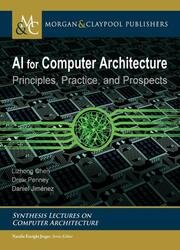AI for Computer Architecture: Principles, Practice, and Prospects
- Добавил: literator
- Дата: 13-01-2021, 04:53
- Комментариев: 0
 Название: AI for Computer Architecture: Principles, Practice, and Prospects
Название: AI for Computer Architecture: Principles, Practice, and ProspectsАвтор: Lizhong Chen, Drew Penney, Daniel Jimenez
Издательство: Morgan & Claypool
Год: 2021
Страниц: 144
Язык: английский
Формат: pdf (true)
Размер: 10.1 MB
Artificial Intelligence (AI) has already enabled pivotal advances in diverse fields, yet its impact on computer architecture has only just begun. In particular, recent work has explored broader application to the design, optimization, and simulation of computer architecture. Notably, machine-learning-based strategies often surpass prior state-of-the-art analytical, heuristic, and human-expert approaches. This book reviews the application of machine learning in system-wide simulation and run-time optimization, and in many individual components such as caches/memories, branch predictors, networks-on-chip, and GPUs. The book further analyzes current practice to highlight useful design strategies and identify areas for future work, based on optimized implementation strategies, opportune extensions to existing work, and ambitious long term possibilities. Taken together, these strategies and techniques present a promising future for increasingly automated computer architecture designs.
Chapter 1 sets the stage for AI in architecture with a brief perspective on the growing need for alternative design strategies and the opportunities offered by AI-based designs. We continue to develop intuition on these opportunities in Chapter 2 while connecting fundamental AI principles to brief architectural examples, thus building a foundation for later chapters. These principles are quickly put into practice in Chapters 3 and 4 as we explore the vast range of AI applications in architecture and then examine three case studies based on prevalent AI-based design approaches. These case studies are intended to provide deeper insight into recent work using supervised learning, reinforcement learning, and unsupervised learning to address challenging architectural problems. With all these applications in mind, Chapter 5 offers a more critical perspective on practical considerations that may guide future work. This analysis involves high-level choices such as model selection as well as some task-specific optimizations for data collection and training overhead. The book culminates in Chapter 6 as we highlight promising opportunities for future work. We hope that AI-based design continues to flourish and that this book encourages new practitioners to embrace increasingly automated architecture design.
Topics:
Computer architecture,
Artificial intelligence,
Machine learning,
Automated architecture design,
Design space exploration,
Design optimization,
Supervised learning,
Unsupervised learning,
Semi-supervised learning,
Reinforcement learning
Скачать AI for Computer Architecture: Principles, Practice, and Prospects
Внимание
Уважаемый посетитель, Вы зашли на сайт как незарегистрированный пользователь.
Мы рекомендуем Вам зарегистрироваться либо войти на сайт под своим именем.
Уважаемый посетитель, Вы зашли на сайт как незарегистрированный пользователь.
Мы рекомендуем Вам зарегистрироваться либо войти на сайт под своим именем.
Информация
Посетители, находящиеся в группе Гости, не могут оставлять комментарии к данной публикации.
Посетители, находящиеся в группе Гости, не могут оставлять комментарии к данной публикации.
